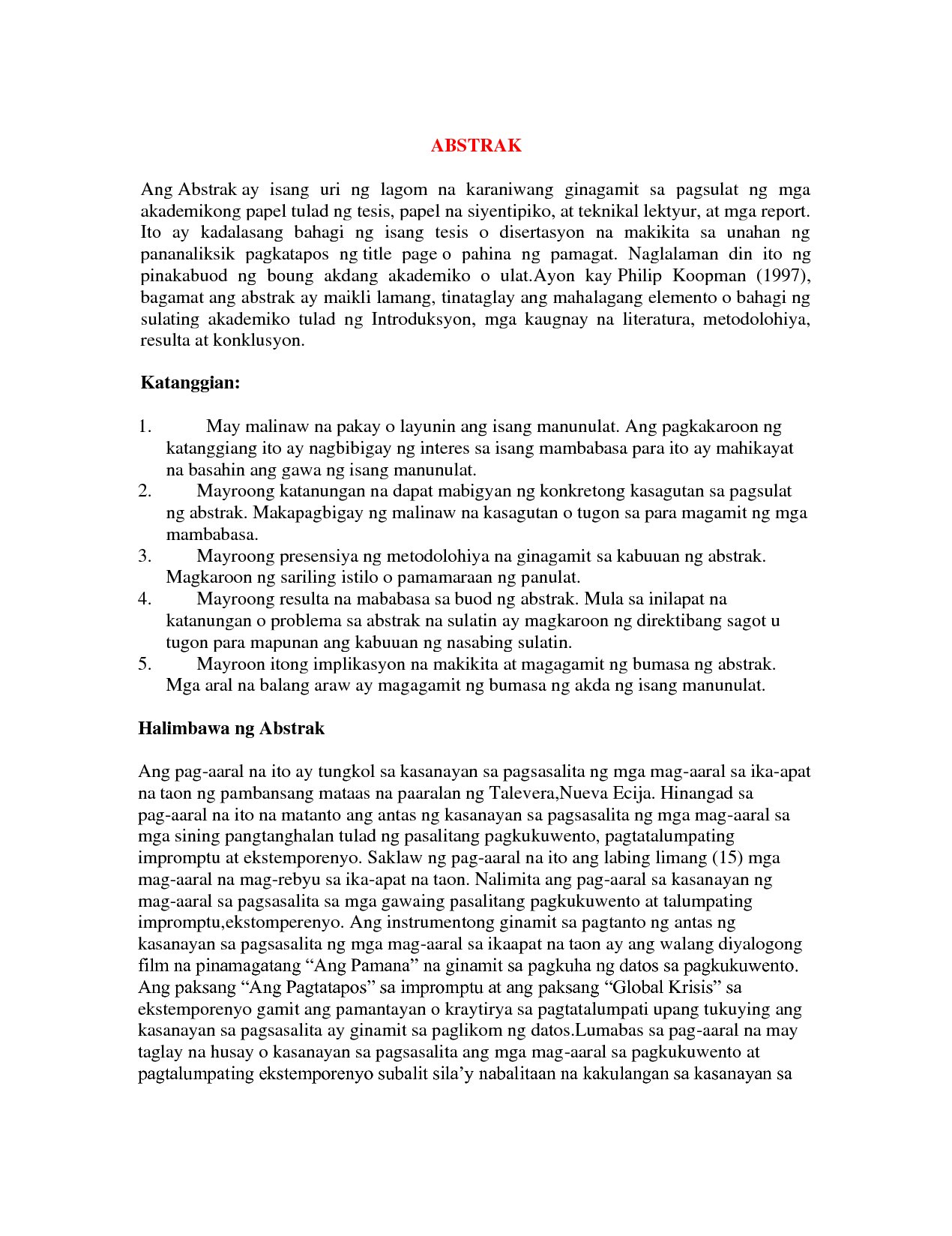Looking for examples of abstraks in akademikong sulatin? You’ve come to the right place! In this blog article, we’ll explore halimbawa ng abstrak sa akademikong sulatin and provide you with some valuable insights. Whether you’re a student, researcher, or simply curious about academic writing, understanding how to craft a compelling abstrak is essential. So, let’s dive in and explore the world of abstrak sa akademikong sulatin together!
Halimbawa ng Abstrak sa Akademikong Sulatin
Writing an abstract is an essential skill in academic writing. It serves as a concise summary of a research paper, thesis, or any formal written work. In this article, we will explore the concept of an abstract in academic writing and provide you with some halimbawa ng abstrak sa akademikong sulatin (examples of abstracts in academic writing). So let’s dive in and learn more about this important element of scholarly communication.
What is an Abstract?
An abstract is a concise and comprehensive summary of a scholarly paper or research project. It is typically written in a single paragraph and provides a brief overview of the main points and findings of the study. The purpose of an abstract is to help readers determine the relevance and significance of the work without having to read the entire paper.
The Components of an Abstract
To effectively summarize a research paper, an abstract should include the following components:
1. Background: Provide a brief introduction to the topic and explain the context or problem that the study aims to address.
2. Objective: Clearly state the research objective or question that the study seeks to answer.
3. Methodology: Describe the methods or approach used to conduct the study, including the sample size, data collection methods, and analysis techniques.
4. Results: Summarize the main findings or outcomes of the research. Include any statistical data or significant findings.
5. Conclusion: Present the main conclusions or implications of the study based on the results obtained.
6. Keywords: Include a list of relevant keywords that will help readers find the abstract when searching for related topics.
Halimbawa ng Abstrak sa Akademikong Sulatin
Now let’s explore some examples of abstracts in academic writing across different disciplines:
Example 1: Social Science
Abstract: This study examines the impact of social media on the mental well-being of adolescents. A sample of 500 students from various high schools was surveyed using a self-report questionnaire. The results indicate a significant correlation between excessive social media use and symptoms of anxiety and depression. The findings highlight the need for educational interventions and parental guidance to promote healthier social media habits among adolescents.
Example 2: Natural Sciences
Abstract: This research investigates the effects of temperature and pH on the enzymatic activity of amylase. A series of experiments were conducted using varying temperatures (25°C, 37°C, 50°C) and pH levels (pH 4, pH 7, pH 10). The results demonstrate that amylase exhibits optimal activity at 37°C and pH 7. These findings contribute to our understanding of enzyme kinetics and have implications for industrial applications such as food processing and biofuel production.
Example 3: Humanities
Abstract: This paper analyzes the recurring themes of love and betrayal in Shakespeare’s tragedy, “Othello.” Through a close reading of the text, the study explores how the characters’ motivations and actions are driven by these emotions. The analysis reveals the destructive consequences of jealousy and manipulation, shedding light on the complexities of human relationships. This research contributes to the ongoing scholarly discourse on Shakespearean tragedies and the exploration of universal human experiences.
Tips for Writing an Effective Abstract
To ensure that your abstract effectively summarizes your research paper or thesis, consider the following tips:
- Keep it concise: Aim for a word count of around 150 to 300 words.
- Focus on the key points: Emphasize the most significant findings and contributions of your study.
- Use clear and concise language: Avoid jargon and technical terms that may be unfamiliar to readers outside your field.
- Be accurate: Provide an honest and objective summary of your research findings.
- Proofread for clarity and coherence: Ensure that your abstract is well-written and flows smoothly.
In academic writing, an abstract plays a crucial role in summarizing the main points and findings of a research paper. It helps readers quickly assess the relevance and importance of the study without having to read the entire paper. By following the guidelines and examples provided in this article, you will be able to write effective abstracts that enhance the impact and accessibility of your academic work.
ABSTRAK: AKADEMIKONG SULATIN | TEACHER KATE ❤
Frequently Asked Questions
What is an example of an abstract in academic writing?
An abstract in academic writing is a concise summary that provides an overview of a research paper or study. Here is an example of an abstract for an academic writing piece:
“The study explores the impact of social media on adolescent mental health. Using a quantitative approach, data was collected from a sample of 200 participants aged 13-18. Results indicate a significant correlation between increased social media usage and higher levels of anxiety and depression among adolescents. The findings contribute to the growing body of literature on the adverse effects of social media on mental health, highlighting the need for further research and interventions.”
What information should be included in an abstract?
An abstract should include a brief statement of the research problem or topic, the research methodology employed, the main findings or results, and the implications or significance of the study. It is typically written in a concise and objective manner, providing readers with a snapshot of the main points discussed in the full paper.
How long should an abstract be?
The length of an abstract can vary depending on the specific requirements of the academic institution or journal. Generally, abstracts are kept within a range of 150 to 250 words. However, it is important to review the guidelines provided by the target publication or institution to ensure compliance with their word limit requirements.
Can an abstract be written before completing the full paper?
Yes, it is common practice to write an abstract before completing the full paper as it allows the author to summarize their research objectives, methods, and anticipated findings. However, it is essential to revise and refine the abstract after completing the paper to ensure it accurately reflects the final content.
Is an abstract the same as an introduction?
No, an abstract is not the same as an introduction. While both provide an overview of the research, an abstract is a concise summary of the entire paper, whereas an introduction provides background information, context, and the specific research question or hypothesis being addressed. The introduction is typically more detailed and sets the stage for the reader to understand the purpose and significance of the research.
Final Thoughts
In conclusion, the importance of an abstract in academic writing cannot be overstated. It serves as a concise summary of the entire paper, allowing readers to quickly assess its relevance and significance. A good example of an abstract in academic writing provides key information about the research topic, methodology, results, and conclusion. It should be clear, concise, and engaging, enticing readers to delve further into the paper. When writing an abstract, it is crucial to use precise language and provide a glimpse of the main arguments and findings. Halimbawa ng abstrak sa akademikong sulatin is an essential tool for effective communication in the academic sphere.


